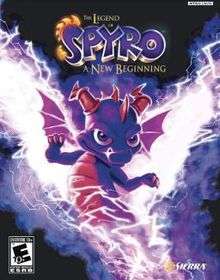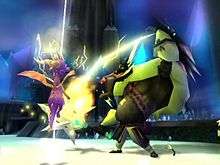The Legend of Spyro: A New Beginning
The Legend of Spyro: A New Beginning is the first game in The Legend of Spyro trilogy, a reboot of the Spyro the Dragon series. It was developed by Krome Studios and published by Vivendi Universal Games for the Game Boy Advance, GameCube, PlayStation 2 and Xbox. Amaze Entertainment developed the Nintendo DS version.
| The Legend of Spyro: A New Beginning | |
|---|---|
 | |
| Developer(s) | Krome Studios (console, GBA) Amaze Entertainment (DS) |
| Publisher(s) | Vivendi Universal Games[lower-alpha 1] |
| Director(s) | Steve Stamatiadis |
| Producer(s) | Chris A. Wilson John Welsh |
| Designer(s) | Cameron Davis (console) |
| Programmer(s) | Steve Williams (Console) David Theodore (GBA) Michael Baird (DS) |
| Artist(s) | Bruno Rime (console) Andrew Gillard (GBA) Lance Myers (DS) |
| Writer(s) | Patrick Hegarty |
| Composer(s) | Rebecca Kneubuhl Gabriel Mann Noel Gabriel (DS) Mark Yeend (DS) |
| Series | The Legend of Spyro |
| Platform(s) | Game Boy Advance, GameCube, PlayStation 2, Xbox, Nintendo DS |
| Release | Game Boy Advance, GameCube, PlayStation 2 & Xbox Nintendo DS |
| Genre(s) | Action |
| Mode(s) | Single-player |
Gameplay

A New Beginning uses a more action-based focus than previous Spyro games. Rather than the previous focus on platforming, the gameplay is now more combat based. Spyro has a variety of combat moves as well as four different breath attacks: fire, electricity, ice and earth, which he can use as both long range and short range attacks. Spyro can also use furies, huge blasts of elemental energy. The game has fewer levels than previous Spyro games, with six levels that progress from a starting point towards a final destination and boss encounter in a linear fashion, and two rail shooter style flying levels adjoining them. It takes about six hours to complete the game.
The DS version has additional attacks and challenges. As well as breath attacks and furies, Spyro can create an elemental shield around himself that protects him from enemies while hurting attacking enemies. Also, the DS version has extra side missions in the form of puzzles.
Plot
The game begins inside a temple, where a large red dragon named Ignitus is watching over an egg; it is the "Year of the Dragon" (not to be confusing with the third Spyro game), a time every twelve years when new dragon eggs are brought to the realm. A dragons' prophecy tells that every ten generations, a rare purple dragon will be born, who will direct the fate of that era; Ignitus is looking after such an egg.
The dragons are, however, at war with an enemy known as the "Dark Master", who also knows of the prophecy, and lays siege to the temple, intent on destroying the brood of eggs. Ignitus escapes with the purple dragon's egg, leaving it to drift downriver into a swamp, hoping for the best. The egg is discovered by a family of dragonflies, and upon hatching, they name the dragon Spyro and adopt him into the family and raise him as one of their own, alongside Sparx, a dragonfly born the same day.
One day, after coming under attack by strange foes and discovering that he can breathe fire, Spyro is told that he is not a dragonfly himself but a stranger from a distant land; Spyro decides to leave the swamp in search of his true home; Sparx, though reluctant at first, decides to follow along. Spyro is pursued by hostile forces, but eventually comes into contact with a distraught Ignitus, who although pleased that Spyro is alive, fears that with the Dragon Temple under occupation by their enemy, led by a black female dragon named Cynder their war is already lost.
Spyro convinces Ignitus to lead him to the Temple, and is able to drive Cynder's forces out, after which Ignitus tells Spyro more about their war against the dark armies, offers Spyro some training in the art of the fire element, and then sends Spyro off to rescue three other dragons from Cynder's forces. One by one, Spyro clashes with Cynder's armies, rescues the three other dragons, Volteer, Cyril, and Terrador, while acquiring new skills and training along the way. It is learned that Cynder has been draining the dragons' power into crystals.
Cynder, however, starts fighting Spyro who shortly after rescues the final Dragon Guardian, Terrador; Ignitus intervenes to fight Cynder but is captured. It is revealed that it was the four dragons who originally sealed away the Dark Master, and that Cynder is using the dragons' drained powers to open the seal. Ignitus's power is the final key in unsealing the Dark Master, so Spyro is sent on a final, direct assault against Cynder's fortress.
Spyro attempts to fight Cynder, but Cynder succeeds in draining Ignitus's power of fire into a crystal, and escapes to the sealed realm of the Dark Master. During the fight, Spyro had noticed there was something familiar in Cynder's eyes. Ignitus then tells Spyro the rest of the story of what happened the night of the attack on the temple. After sending Spyro's egg down the river, Ignitus had returned to see that the Dark Master's forces had destroyed the brood of eggs, except one - for only a dragon born in the Year of the Dragon can open the portal and release the Dark Master: Cynder, who had been transformed by the Dark Master's sinister powers. Ignitus fears that it is too late to stop her, but Spyro pursues Cynder and forces a showdown, eventually using all of his power in a final attack which defeats her, purging her of the Dark Master's influence and returning her to her true form, a young dragoness the same size and age as Spyro. The realm begins to collapse in on itself; Sparx insists on making a quick exit but Spyro declares he will not leave Cynder behind with the Dark Master; though barely, Spyro is able to grab Cynder and escape safely.
Though victorious, the battle cost Spyro much of his own strength and powers, and both Spyro and Cynder suspect that the Dark Master is still alive somewhere; the war is still far from over. The story continues in The Legend of Spyro: The Eternal Night.
Development
Krome Studios were asked by Vivendi Games to develop The Legend of Spyro. After Krome showed Vivendi their technology they were using to develop a Crash Bandicoot game, Sierra asked a prototype for what subsequently became The Legend of Spyro.
The game utilizes the voices of actors, featuring Elijah Wood as the voice of Spyro, Comedian David Spade as Sparx, Cree Summer as Cynder and Gary Oldman as Ignitus.
Reception
| Reception | ||||||||
|---|---|---|---|---|---|---|---|---|
| ||||||||
Apart from the Game Boy Advance version, A New Beginning reviews were mixed. Aggregating review websites GameRankings and Metacritic gave the Xbox version 71.27% and 69/100,[1][6] the Nintendo DS version 68.22% and 68/100,[2][7] the GameCube version 67.17% and 67/100,[3][8] the PlayStation 2 version 64.52% and 64/100[4][9] and the Game Boy Advance version 44.67% and 44/100.[5][10]
IGN stated, "The franchise has gotten a serious lift in nearly every area. The overall gameplay was extremely solid for a children's title, the overall presentation was baffling complex – with everything from scripted story events and innovative enemy entrances – and the overall audio/graphical design is definitely stronger than we expected."[11] While Eurogamer stated, "If you loved the original games then that might carry you through to completion but for those who are new, prepare for a long slog."[12]
Sequel
Its success spawned two sequels and a planned CGI movie.
References
| Wikiquote has quotations related to: The Legend of Spyro: A New Beginning |
- Released under the Sierra Entertainment brand name
- "The Legend of Spyro: A New Beginning for Xbox". GameRankings. Retrieved October 2, 2013.
- "The Legend of Spyro: A New Beginning for DS". GameRankings. Retrieved October 2, 2013.
- "The Legend of Spyro: A New Beginning for GameCube". GameRankings. Retrieved October 2, 2013.
- "The Legend of Spyro: A New Beginning for PlayStation 2". GameRankings. Retrieved October 2, 2013.
- "The Legend of Spyro: A New Beginning for Game Boy Advance". GameRankings. Retrieved October 2, 2013.
- "The Legend of Spyro: A New Beginning for Xbox Reviews". Metacritic. Retrieved October 2, 2013.
- "The Legend of Spyro: A New Beginning for DS Reviews". Metacritic. Retrieved October 2, 2013.
- "The Legend of Spyro: A New Beginning for GameCube Reviews". Metacritic. Retrieved October 2, 2013.
- "The Legend of Spyro: A New Beginning for PlayStation 2 Reviews". Metacritic. Retrieved October 2, 2013.
- "The Legend of Spyro: A New Beginning for Game Boy Advance Reviews". Metacritic. Retrieved October 2, 2013.
- Bozon, Mark (October 19, 2006), The Legend of Spyro: A New Beginning - IGN, retrieved 2020-04-06
- Smith, Lesley (2006-11-05). "The Legend of Spyro: A New Beginning". Eurogamer. Retrieved 2020-04-06.